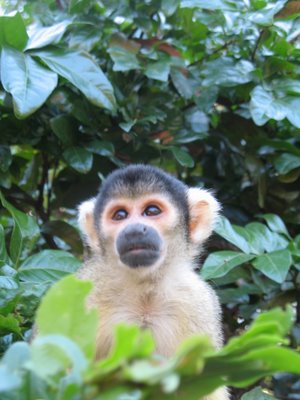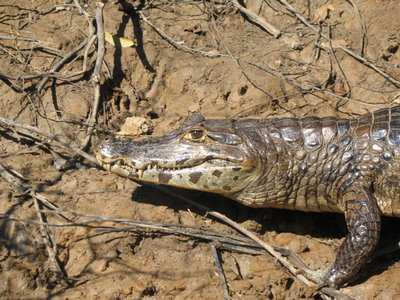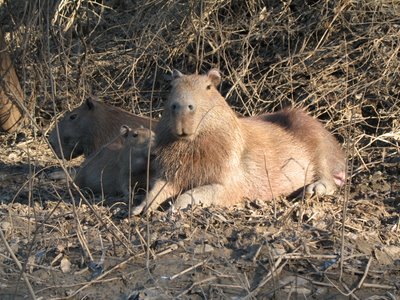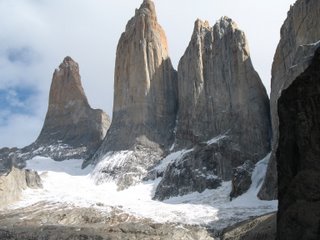Into the Bolivian Amazon
Faced with an 18 hour bus journey along a reputedly terrible road, I chose to fly to Rurranabaque. However, rain delayed the flight and after waiting most of the day at La Paz airport, I was lucky to squeeze onto the last flight of the day. The plane hopped over the nearby Cordillera Real and passed incredibly close to 6000m Huayni Potosi before descending into the rainforest and landing on a grass runway.
The next day, I was met by my guide, Ghiovani, and we took a boat five hours up the Beni and Tuichi rivers to the Chalalan resort while more rain fell. Along the way, Ghiovani pointed out river birds such as egrets and kingfishers and we also spotted a few capybararas from a distance. Its a short thirty minute walk from the river to the comfortable wood huts which were to be my home for the next three days. Chalalan is a real eco-tourism success story. Its situated inside Madidi National Park - one of the most biodiverse regions on the planet. The park stretches down from the glaciated Apoploblamba mountains through cloud forest down to Amazon tributaries like the Beni river. Its funded by international conservation agencies and staffed by members of the nearest village, three hours upriver - people who know and love the forest their community lives in. Profits go towards improving health and education facilities for the village and as such it finds itself in a much stronger position than those that have had to rely on the Bolivian Government. The eco-lodge itself is beautifully situated next to a small lake, surrounded by pristine rainforest and the only real concession made to modern life is in the form of the electricity supplied from a solar generator.

The group sizes at Chalalan are kept small to inprove the chances of seeing wildlife and I was sharing my guide with a friendly Australian couple. Later that afternoon, Ghiovani took us on a short walk through the nearby forest, pointing out medicinal and other practical uses for the trees we encountered en route. Two which stood out were the pink flowered may tree and the incredible walking tree which has roots overground and is able to relocate its position in the forest over time. Our return to the Eco-Lodge was by canoe along the lake. Ghiovani, was clearly enjoying himself as he located an acrobatic collection of squirrel and capuchin monkeys taking a late afternoon snack on fruit trees bordering the lake. Pairs of macaws flew overhead, aninguas and herons sat perched at strategic positions in the trees, while the cowbirds (hoatzin) made their presence felt with their own distinctive sounds. Ghiovani seemed to be able to identify each bird species at a great distance and could imitate almost every call. After dinner we went back into the forest to look for nocturnal wildlife. Ghiovani quickly located a tarantula nest and tempted a giant spider out using a small stick laced with saliva for bait. It was an unnerving sight as the huge arachnid lunged for the stick, then scuttled back into its nest. Brief sightings of an opossum and a night monkey (the only nocturnal species in the amazon) followed to round off an amazing first day.

I awoke the next day feeling very refreshed, there is a tranquility to the rainforest which draws you in. It had been a cool cloudy night and the forest was unusually quiet. The main focus of the mornings walk was bird spotting. Ghiovani eventually carefully tracked down a pair of red and green macaws and along the way we also spotted woodpeckers, tanagers, tree creepers, tropical kingbirds and oropendola. Its difficult trying to spot birds in the dense undergrowth and it was the sounds that really brought the whole experience to life. On our return for lunch we came across a large group of white lipped peccaries, who thundered off into the forest, when they became aware of our presence. These agressive wild boar have been known to eat humans when threatened and it was quite an experience to watch them size us up and then beat a noisy retreat. The afternoon yielded sightings of plenty of blue and yellow macaws, as well as some parakeets and we finished the day with another relaxing boat ride on the lake.
On my final day, the cloud finally lifted and the sun broke through and brought the rainforest to life with the familiar sound of the cicada dominating. It was to prove an excellent morning for tropical birds, with parrots, toucans, trogons, hummingbirds, flycatchers and a beautiful red-headed manakin among those seen along with plenty more squirrel and capuchin monkeys. We also saw fresh tracks belonging to agoutis and tapirs and armadillo nests but all of these elusive jungle creatures remained hidden. Late afternoon out on the water, Ghiovani finally spotted some red howler monkeys - a pair sat high the trees looking out over the lake. Howlers don´t tend to move much during the colder weather and clearly the sun had brought them out of their slumber in search of food. They seemed unusually quiet compared to howlers I had previously encountered in Mexico and Guatemala, but I am told they only make a real noise when territorially threatened by other groups of howlers. With no others in sight, they seemed content to continue their siesta. While Ghiovani rowed back to base, a caiman drifted nearby, but kept its distance and overheard a blue-throated piping guan called out.
It was a real shame to leave the next day. The experience had been quite amazing. Ghiovani told me to keep an eye out along the banks for jaguars as we got the boat back to Rurranabaque but of course the Amazon´s top predator eluded us. Sightings are very rare and most guides only see about one a year. The riverbank however, was alive with raptors, with three different species of vulture, caracara and other hawks aplenty.

From Rurranabaque its 3 hours drive east into the tropical savannah to the Yacuma river. Another prime sight from which to see the inhabitants of the Amazon. Here the trips are taken in a motorised canoe and there are plenty of caimans for company - approximately one every twenty metres or so, sunning themselves on the riverbank. The common caiman grows to two or three metres and poses no threat to humans. In fact, most feel threatened by the presence of the boat and slink quietly into the water as we pass by. Much rarer is the black caiman, which can grow to six metres - these are much more aggressive and have been known to attack humans who are tempted to cool off in the water.
Gliding along the river is great for bird watching. Heron and egrets are very common and come in snowy, white-necked, striated and tiger varieties. Larger birds such as jabiru, woodbills, vultures and kites sit high in their vantage points atop dead trees, whilst colourful tropical birds dance between the undergrowth. Some of the more notable among them include kingfishers, tropials, red-headed cardinals, yacumas, caciques and kiskadees.

For me though, the highlights had to be pink river dolphins, capybaras and howler monkeys - both red and black howlers were seen here. The dolphins surface briefly to breathe and never really jump out of the water like their ocean counterparts. As such they prove almost impossible to photograph. Capybaras are the worlds largest rodent and are usually seen on the riverbanks, although they do like to swim also but perhaps not when there are so many caimans about. We got incredibly close to a large group of them, who seemed completely unthreatened by our presence. The black howler monkeys here are different to their relatives in Central America, where both male and female are a uniform black colour. Here a single black male is usually found a harem of yellow females. The howlers were again disapointingly quiet and I left the Amazon having not heard a single howler scream. At night, we were treated to more nocturnal delights - some night monkeys came out to feed in a papaya tree, soon followed by a most unusual sight - a white necked porcupine rustling its way up and down a palm tree while it munched on some leaves. I was left with the impression that a longer stay would have been even more rewarding - anteaters and sloths are also relatively common sightings. However, the days were passing by and I hadn´t really seen much of the Andes yet in Bolivia.
Faced with an 18 hour bus journey along a reputedly terrible road, I chose to fly to Rurranabaque. However, rain delayed the flight and after waiting most of the day at La Paz airport, I was lucky to squeeze onto the last flight of the day. The plane hopped over the nearby Cordillera Real and passed incredibly close to 6000m Huayni Potosi before descending into the rainforest and landing on a grass runway.
The next day, I was met by my guide, Ghiovani, and we took a boat five hours up the Beni and Tuichi rivers to the Chalalan resort while more rain fell. Along the way, Ghiovani pointed out river birds such as egrets and kingfishers and we also spotted a few capybararas from a distance. Its a short thirty minute walk from the river to the comfortable wood huts which were to be my home for the next three days. Chalalan is a real eco-tourism success story. Its situated inside Madidi National Park - one of the most biodiverse regions on the planet. The park stretches down from the glaciated Apoploblamba mountains through cloud forest down to Amazon tributaries like the Beni river. Its funded by international conservation agencies and staffed by members of the nearest village, three hours upriver - people who know and love the forest their community lives in. Profits go towards improving health and education facilities for the village and as such it finds itself in a much stronger position than those that have had to rely on the Bolivian Government. The eco-lodge itself is beautifully situated next to a small lake, surrounded by pristine rainforest and the only real concession made to modern life is in the form of the electricity supplied from a solar generator.

The group sizes at Chalalan are kept small to inprove the chances of seeing wildlife and I was sharing my guide with a friendly Australian couple. Later that afternoon, Ghiovani took us on a short walk through the nearby forest, pointing out medicinal and other practical uses for the trees we encountered en route. Two which stood out were the pink flowered may tree and the incredible walking tree which has roots overground and is able to relocate its position in the forest over time. Our return to the Eco-Lodge was by canoe along the lake. Ghiovani, was clearly enjoying himself as he located an acrobatic collection of squirrel and capuchin monkeys taking a late afternoon snack on fruit trees bordering the lake. Pairs of macaws flew overhead, aninguas and herons sat perched at strategic positions in the trees, while the cowbirds (hoatzin) made their presence felt with their own distinctive sounds. Ghiovani seemed to be able to identify each bird species at a great distance and could imitate almost every call. After dinner we went back into the forest to look for nocturnal wildlife. Ghiovani quickly located a tarantula nest and tempted a giant spider out using a small stick laced with saliva for bait. It was an unnerving sight as the huge arachnid lunged for the stick, then scuttled back into its nest. Brief sightings of an opossum and a night monkey (the only nocturnal species in the amazon) followed to round off an amazing first day.

I awoke the next day feeling very refreshed, there is a tranquility to the rainforest which draws you in. It had been a cool cloudy night and the forest was unusually quiet. The main focus of the mornings walk was bird spotting. Ghiovani eventually carefully tracked down a pair of red and green macaws and along the way we also spotted woodpeckers, tanagers, tree creepers, tropical kingbirds and oropendola. Its difficult trying to spot birds in the dense undergrowth and it was the sounds that really brought the whole experience to life. On our return for lunch we came across a large group of white lipped peccaries, who thundered off into the forest, when they became aware of our presence. These agressive wild boar have been known to eat humans when threatened and it was quite an experience to watch them size us up and then beat a noisy retreat. The afternoon yielded sightings of plenty of blue and yellow macaws, as well as some parakeets and we finished the day with another relaxing boat ride on the lake.
On my final day, the cloud finally lifted and the sun broke through and brought the rainforest to life with the familiar sound of the cicada dominating. It was to prove an excellent morning for tropical birds, with parrots, toucans, trogons, hummingbirds, flycatchers and a beautiful red-headed manakin among those seen along with plenty more squirrel and capuchin monkeys. We also saw fresh tracks belonging to agoutis and tapirs and armadillo nests but all of these elusive jungle creatures remained hidden. Late afternoon out on the water, Ghiovani finally spotted some red howler monkeys - a pair sat high the trees looking out over the lake. Howlers don´t tend to move much during the colder weather and clearly the sun had brought them out of their slumber in search of food. They seemed unusually quiet compared to howlers I had previously encountered in Mexico and Guatemala, but I am told they only make a real noise when territorially threatened by other groups of howlers. With no others in sight, they seemed content to continue their siesta. While Ghiovani rowed back to base, a caiman drifted nearby, but kept its distance and overheard a blue-throated piping guan called out.
It was a real shame to leave the next day. The experience had been quite amazing. Ghiovani told me to keep an eye out along the banks for jaguars as we got the boat back to Rurranabaque but of course the Amazon´s top predator eluded us. Sightings are very rare and most guides only see about one a year. The riverbank however, was alive with raptors, with three different species of vulture, caracara and other hawks aplenty.

From Rurranabaque its 3 hours drive east into the tropical savannah to the Yacuma river. Another prime sight from which to see the inhabitants of the Amazon. Here the trips are taken in a motorised canoe and there are plenty of caimans for company - approximately one every twenty metres or so, sunning themselves on the riverbank. The common caiman grows to two or three metres and poses no threat to humans. In fact, most feel threatened by the presence of the boat and slink quietly into the water as we pass by. Much rarer is the black caiman, which can grow to six metres - these are much more aggressive and have been known to attack humans who are tempted to cool off in the water.
Gliding along the river is great for bird watching. Heron and egrets are very common and come in snowy, white-necked, striated and tiger varieties. Larger birds such as jabiru, woodbills, vultures and kites sit high in their vantage points atop dead trees, whilst colourful tropical birds dance between the undergrowth. Some of the more notable among them include kingfishers, tropials, red-headed cardinals, yacumas, caciques and kiskadees.

For me though, the highlights had to be pink river dolphins, capybaras and howler monkeys - both red and black howlers were seen here. The dolphins surface briefly to breathe and never really jump out of the water like their ocean counterparts. As such they prove almost impossible to photograph. Capybaras are the worlds largest rodent and are usually seen on the riverbanks, although they do like to swim also but perhaps not when there are so many caimans about. We got incredibly close to a large group of them, who seemed completely unthreatened by our presence. The black howler monkeys here are different to their relatives in Central America, where both male and female are a uniform black colour. Here a single black male is usually found a harem of yellow females. The howlers were again disapointingly quiet and I left the Amazon having not heard a single howler scream. At night, we were treated to more nocturnal delights - some night monkeys came out to feed in a papaya tree, soon followed by a most unusual sight - a white necked porcupine rustling its way up and down a palm tree while it munched on some leaves. I was left with the impression that a longer stay would have been even more rewarding - anteaters and sloths are also relatively common sightings. However, the days were passing by and I hadn´t really seen much of the Andes yet in Bolivia.


0 Comments:
Post a Comment
<< Home